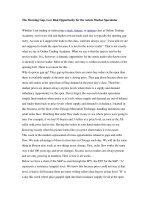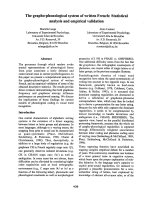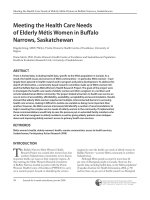The Next Growth Opportunity for Banks: How the Post-Crisis Financial Needs of Younger Consumers Will Transform Retail Banking Services pdf
Bạn đang xem bản rút gọn của tài liệu. Xem và tải ngay bản đầy đủ của tài liệu tại đây (2.81 MB, 32 trang )
Cisco Internet Business Solutions Group (IBSG)
Cisco IBSG © 2010 Cisco and/or its affiliates. All rights reserved.
Survey Report
The Next Growth Opportunity for Banks
How the Post-Crisis Financial Needs of Younger
Consumers Will Transform Retail Banking Services
Authors
Philip Farah
James Macaulay
Jörgen Ericsson
February 2010
Cisco IBSG © 2010 Cisco and/or its affiliates. All rights reserved. Page 2
Survey Report
The Next Growth Opportunity for Banks
How the Post-Crisis Financial Needs of Younger Consumers Will Transform
Retail Banking Services
Executive Summary
●
The current banking environment of low interest rates combined with high charge-offs
and delinquencies is making it difficult for banks to generate revenue in traditional
ways.
●
In October 2009, the Cisco Internet Business Solutions Group (IBSG) conducted a
survey of 1,055 U.S. consumers to explore their evolving financial priorities,
expectations for services from banks, and interaction preferences.
1
●
While consumers have faced significant financial strain due to a deteriorating job
outlook and dwindling asset values, they have also embraced new technologies,
including mobility and video, and adopted online behaviors, such as social networking,
at an astonishing rate. These trends are particularly true for younger consumers.
●
The survey clearly shows that the rise of younger generations will have a profound
impact on retail banking, providing the next opportunity for revenue growth:
– Younger customers need help. Generation Y (also known as “Millennials,” and
defined for the purposes of this survey as consumers born between 1980 and
1992) and Generation X (consumers born approximately between 1960 and 1979)
are under financial pressure. Both groups need and want advice about how to
manage their day-to-day finances, such as getting out of debt and saving for the
future. This focus on personal financial management (PFM) is central to emerging
revenue growth opportunities for banks.
– Younger customers trust banks to help them. Despite challenges caused by the
economic crisis, Gen Y and Gen X customers still trust their banks and want them
to be their primary providers of advice.
– To be successful with younger customers, a new approach to retail banking
is required. Younger customers want banks to address their needs using the
tools they and their peers have adopted, including mobile devices, video, and
social networking—and they are willing to switch to banks that embrace these
technologies.
●
This is good news for banks that have struggled to scale cost effectively the delivery
of advice to market segments beyond high-net-worth (HNW) individuals.
●
Cisco IBSG tested three related concepts to better understand their appeal with
different consumer segments and to help banks focus on the right approach:
1. Automated advice, such as PFM capabilities, to help customers gain control of
their finances
2. High-quality video interactions to provide on-demand advice in branches and
at home
Cisco IBSG © 2010 Cisco and/or its affiliates. All rights reserved. Page 3
Survey Report
3. Community-of-interest and social networking venues to offer virtualized,
on-demand advice
●
As a result, Cisco IBSG has identified an integrated value proposition that incorporates
the concepts of self-service as well as virtual and community-based advice to address
the needs of Gen Y (and, to a large extent, Gen X) consumers.
●
The potential of this approach is significant. In fact, Cisco IBSG estimates retail banks
can increase revenues by 5 to 10 percent. This figure is mainly driven by an increase in
the cross-sell ratio. It also takes into account greater deposits resulting from highly
targeted offers that are derived from better customer intimacy and the status of being
a “bank of choice.” Finally, the figure considers an increase in customer acquisition
rates.
●
Recent public results from the retail banking industry have shown that users of PFM
tools are more profitable, have higher balances, consume more products and services,
and are less likely to leave for another bank.
2
For example, PFM users at SAFE Credit
Union were found to be three times more profitable, had balances of $14,500 versus
$8,300, and averaged 5.7 accounts as compared to 3.6 for all households.
3
It is
interesting to note that these figures were also much higher between PFM users and
online banking users.
●
In addition, Cisco IBSG further validated its estimate of revenue gains using customers
that pay their bills online as a proxy. Public statistics from SunTrust indicate that the
attrition rate for online bill payers is less than half that of average customers. In
addition, these customers own 1.5 times more products and carry 1.6 times higher
balances.
4
A Difficult Climate for Growth
As the world emerges from the global financial crisis, banks find themselves in a challenging
environment. Low interest rates are making it difficult to generate revenue in traditional ways,
while raising capital and reducing risk have become the new priorities. Moreover,
households in the United States witnessed an aggregate decline in wealth of nearly 18
percent in just a 12-month period—a sum of money roughly equivalent to the combined
gross domestic product (GDP) of Germany, Japan, and the United Kingdom.
5
Additionally,
many pitfalls, including persistently high unemployment and stubbornly depressed real
estate values, still threaten to derail a full and robust recovery. Given this situation, it is critical
that banks find and take advantage of new ways to generate revenue.
Cisco IBSG believes Gen Y and Gen X consumers are becoming increasingly strategic
customer segments for banks. While the net worth of Gen Y and Gen X understandably trails
that of people born before 1960 (baby-boomer and silver generations), their disposable
income is fast approaching that of their elders.
6
Within the decade, Gen Y alone will supplant
baby boomers and silvers as the largest customer segment by population (see Figure 1).
Cisco IBSG © 2010 Cisco and/or its affiliates. All rights reserved. Page 4
Survey Report
Figure 1. U.S. Population Distribution by Generation
Although banks have invested heavily in meeting the financial needs of baby boomers, this
segment has seen its financial prospects dim with the recent collapse of asset values. Many
baby boomers are pushing out plans to retire, revisiting their portfolios, and spending less.
As a result, brands in other industries that have relied disproportionately on this segment of
the consumer market have taken a beating.
7
Many such companies are now seeking new avenues for growth through products and
services that target younger generations of consumers. Although increasing restraint and
financial anxiety on the part of baby boomers do not necessarily denote trouble for banks,
interest and fee income associated with older consumers is at greater risk than in the past
due to a decreased appetite for new loans and the coming transfer of wealth to younger
generations.
Consumers Need and Want Financial Advice
Cisco IBSG’s survey findings point to an unmistakable movement in consumer financial
priorities toward stability and deleveraging. Many consumers have been shaken by the
economic events of the past two years and are clearly worried about their financial security
(see Figure 2).
Source: “The Future of U.S. Consumer Spending: It’s a Generational Thing,” SeekingAlpha.com, October 2009.
Cisco IBSG © 2010 Cisco and/or its affiliates. All rights reserved. Page 5
Survey Report
Figure 2. Top Financial Concerns of U.S. Consumers
Although all age groups want to get their financial houses in order, the economic crisis has
spawned a sizable consumer segment that values access to financial expertise focused on
controlling spending and revamping investment strategies for sustainable growth. These
consumers also tend to be younger and are more active users of technology. Understanding
the needs of these consumers is crucial as banks navigate today’s landscape for financial
services.
Among consumers interviewed, Gen Y and Gen X respondents registered the highest levels
of concern with respect to employment status. Both groups are more worried about the
security of their existing position or their ability to find a job (see Figure 3) than are baby
boomers and silvers.
Source: Cisco IBSG, October 2009
Cisco IBSG © 2010 Cisco and/or its affiliates. All rights reserved. Page 6
Survey Report
Figure 3. Employment Concerns of U.S. Consumers
Gen X consumers are particularly feeling the pinch. In fact, many find they cannot make ends
meet (see Figure 4) or that they are overextended financially (see Figure 5). This is likely
because of their current career phase and responsibilities of providing for children (and, in
some cases, for parents).
Figure 4. Cannot Make “Ends Meet”
Source: Cisco IBSG, October 2009
Source: Cisco IBSG, October 2009
Cisco IBSG © 2010 Cisco and/or its affiliates. All rights reserved. Page 7
Survey Report
Figure 5. Carrying Too Much Debt
Gen X and, to a lesser degree, Gen Y are also more concerned than other consumer
demographic groups regarding adequate saving levels to meet long-term goals
(see Figure 6).
Figure 6. Not Saving Enough for Long-Term Goals
Source: Cisco IBSG, October 2009
Source: Cisco IBSG, October 2009
Cisco IBSG © 2010 Cisco and/or its affiliates. All rights reserved. Page 8
Survey Report
Consumers were clear that, in an era marked by dramatic declines in wealth and by
increasing economic insecurity, financial advice and savings savvy are highly valued.
Consumers in the early stages of their careers and financial lives need the most help in
managing their finances, and are seeking opportunities to educate themselves about money
matters. The Cisco IBSG study revealed that more than one-third of both Gen Y and Gen X
consumers feel they need assistance managing their financial affairs, while less than one-
fifth of boomers and silvers feel the same way (see Figure 7).
Figure 7. Percentage of Consumers Who Feel They Need “Help Managing Finances”
This suggests banks’ collective emphasis on older consumers for financial advice offerings
may obscure a vital opportunity in terms of long-term differentiation and revenue generation.
Further, the majority of bank-delivered financial advisory services have focused chiefly on
investment advice that, while still critical, only partially aligns with crystallizing PFM priorities
of expense management, debt reduction, and financial education.
It comes as no surprise that younger people need advice since they are embarking on new
ventures, finding employment, establishing credit, making big-ticket purchases, and funding
their education. To date, however, even acknowledging the high-margin nature and cross-
sell potential of advisory services, extending this business to younger customer segments
has been historically unattractive for banks. In-person delivery through the branch channel,
the primary vehicle through which banks have dispensed financial advice, is a costly
proposition for banks. A mounting need for financial advice on the part of younger
consumers, however, as well as a transformation of the underlying economic logic of
delivery channels afforded by technology (through remote advice, virtual consultations, self-
service monitoring of financial status, and peer-supported advisory models), warrants a
re-examination of this opportunity.
Source: Cisco IBSG, October 2009
Cisco IBSG © 2010 Cisco and/or its affiliates. All rights reserved. Page 9
Survey Report
Younger and older consumers both cite professional financial advisors as their preferred
source of assistance for financial decisions. Gen Y and Gen X also show budding interest
in using social networking, online communities of interest, and sharing of experiences and
information with other customers (see Figure 8).
Figure 8. Preferred Methods for Receiving Financial Advice
Younger Consumers Look to Their Banks First for Advice
Consumer generations diverge in where they turn for financial information (see Figure 9).
Gen Y is more likely to depend upon a bank (rather than an independent advisor, broker, or
other source). This underscores the potential for banks to deepen relationships with—and
provide targeted advice to—Gen Y consumers. Gen Y makes significantly more frequent
use of both family and friend networks for financial advice and consults social networking
and other online sites more often than older consumers, underlining the potential of peer-
supported online communities.
Source: Cisco IBSG, October 2009
Cisco IBSG © 2010 Cisco and/or its affiliates. All rights reserved. Page 10
Survey Report
Figure 9. Where Consumers Turn for Financial Information
Despite a common perception that banks are held in lower regard today than ever before,
Cisco IBSG’s data actually suggest consumers are decidedly satisfied with their primary
banking relationship. Eighty-eight percent of all consumers surveyed were either satisfied
or very satisfied with their current bank (see Figure 10). Banks, therefore, appear well
positioned, despite recent travails, to establish themselves as providers of choice for new
financial advisory services.
Source: Cisco IBSG, October 2009
Cisco IBSG © 2010 Cisco and/or its affiliates. All rights reserved. Page 11
Survey Report
Figure 10. Satisfaction with Current Bank
Although they are mostly content with the services they receive from banks now, Gen Y and
Gen X are also the most open to switching banks: 26 percent of Gen Y and 23 percent of
Gen X respondents indicated they would consider moving their primary banking relationship
elsewhere. This compares with just 13 percent of baby boomers and silvers (see Figure 11).
While banks may be in a strong position to target younger consumers with advice-oriented
products and services, these findings suggest they may also be vulnerable to first-mover
rivals.
Source: Cisco IBSG, October 2009
Cisco IBSG © 2010 Cisco and/or its affiliates. All rights reserved. Page 12
Survey Report
Figure 11. Willingness to Switch Banks (7 or Higher on a 10-Point Scale, Where 10 Is “Extremely Willing”)
Younger Consumers Adopt New Methods of Information Delivery
Younger consumers tend to be more connected and employ technology more frequently.
Cisco IBSG found that mobile phone use among younger consumers is truly ubiquitous,
with penetration rates of 97 percent for Gen Y and 91 percent for Gen X. And although
mobile banking penetration remains relatively low, Gen Y and Gen X make significantly
more use of these capabilities.
Younger consumers also tend to take greater advantage of video. Cisco IBSG found that
53 percent of Gen Y and 40 percent of Gen X customers have used online video chat
capabilities such as Skype. Moreover, for these consumers, online video extends not
just to day-to-day communications with friends and family, but also to information and
entertainment purposes—20 percent of Gen Y consumers visit YouTube multiple times
per day (see Figure 12).
Source: Cisco IBSG, October 2009
Cisco IBSG © 2010 Cisco and/or its affiliates. All rights reserved. Page 13
Survey Report
Figure 12. Visits to YouTube Multiple Times Per Day
In addition, Gen Y and Gen X have exhibited substantially higher adoption of new online
tools and channels relevant to receiving financial advice (see Figure 13).
Source: Cisco IBSG, October 2009
Cisco IBSG © 2010 Cisco and/or its affiliates. All rights reserved. Page 14
Survey Report
Figure 13. Use of Representative Online Tools and Channels
Gen Y consumers are four times as likely as boomers and silvers to have posted a question
about financial matters to a blog or online forum (see Figure 14). Although the penetration of
online financial communities and social networking for financial matters remains modest, the
comparison across generations is stark.
Source: Cisco IBSG, October 2009
Cisco IBSG © 2010 Cisco and/or its affiliates. All rights reserved. Page 15
Survey Report
Figure 14. Percentage of Respondents Who Posted Questions About Finance and Investing to Blogs and
Online Forums
Younger consumers have adopted these, and other technologies, to a far greater degree
than their elders. This demonstrates their readiness for innovation in how banking services—
including financial advice—are delivered. The discrepancies among generations in the
adoption of innovative technologies, when coupled with the precedence of distinct financial
priorities among younger generations, underline an important convergence of opportunities
for boosting cross-sell rates, growing wallet share, and lowering customer acquisition and
service costs.
Window of Opportunity Is Open To Deliver Next-Generation
Advisory Services
These findings indicate banks have a tremendous opportunity to provide Gen Y and Gen X
consumers with personalized advice and value propositions. In fact, retail banks that execute
correctly will become financial services providers of choice for these customer categories.
To support this conclusion, Cisco IBSG explored several value propositions related to
delivering advice and conducted a concept test with survey respondents that focused on
the following capabilities:
●
A mobile-enabled online PFM offering that emphasizes a holistic view of customers’
financial situations and behaviors
●
A video-centric advisory model to allow consumers to interact with remote financial
advisors via video kiosks in the branch as well as from the home
●
A bank-moderated community of interest and social networking venue to provide
virtualized advice on demand
The survey findings show consumers of all ages are already making frequent use of PFM
applications. In fact, roughly one in three respondents use some type of PFM tool (see
Figure 15), with Quicken software and, interestingly, tools furnished by banks being the
Source: Cisco IBSG, October 2009
Cisco IBSG © 2010 Cisco and/or its affiliates. All rights reserved. Page 16
Survey Report
dominant resources (see Figure 16). Although only a small percentage of Gen Y
respondents indicated they use Quicken for managing their finances, they were nearly
eight times as likely as boomers and silvers to use Mint, an online PFM site recently acquired
by Intuit, Inc., publisher of Quicken. The average age of Mint users reportedly is 30, while the
average age for Quicken customers is 47.
8
Figure 15. All Age Groups Already Using PFM Applications
Source: Cisco IBSG, October 2009
Cisco IBSG © 2010 Cisco and/or its affiliates. All rights reserved. Page 17
Survey Report
Figure 16. Usage of Specific PFM Tools
In terms of the capabilities offered by PFM tools, budgeting, categorization of expenses,
and overspending alerts were cited as the most valuable (see Figure 17). This is in line
with the wider finding that managing expenses, reducing debt, and maximizing long-term
savings are top-of-mind and areas where help is needed most. Strikingly, across all three
categories—budgeting, expense categorization, and overspending alerts—a higher priority
was placed on these capabilities as the age of respondents decreased. Gen Y and Gen X
value these budgeting and money management capabilities far more than boomers and
silvers do.
Source: Cisco IBSG, October 2009
Cisco IBSG © 2010 Cisco and/or its affiliates. All rights reserved. Page 18
Survey Report
Figure 17. Most Valuable Functionality in PFM Tools
Moreover, nearly one-quarter of Gen Y respondents expressed interest in visualization
functionality that allows users to forecast future holdings and chart progress against goals.
Again, this is far higher than the level of interest shown by older consumers. Also, Gen Y
is much more prepared to tap PFM capabilities while on the move. In fact, more than
10 percent of these consumers are already using a PFM application on their Apple iPhone
(does not include other types of smartphones), and 32 percent are interested in having PFM
functionality available on their mobile devices. This is quadruple the rate of interest among
baby boomers and silvers (see Figure 18).
Source: Cisco IBSG, October 2009
Cisco IBSG © 2010 Cisco and/or its affiliates. All rights reserved. Page 19
Survey Report
Figure 18. Appeal of PFM Functionality on Mobile Phones (7 or Higher on a 10-Point Scale, Where 10 Is
“Extremely Appealing”)
The concept test undertaken by Cisco IBSG yielded some interesting findings, particularly
regarding consumer receptivity to new channels of interaction with banks. The study
suggests that both Gen Y and, to some extent, Gen X consider video-based communication
with their banks a positive differentiator. Nearly 40 percent of Gen Y and fully 30 percent of
Gen X respondents indicated they consider the idea of interacting with remote advisors via
video appealing or very appealing (see Figure 19).
Source: Cisco IBSG, October 2009
Cisco IBSG © 2010 Cisco and/or its affiliates. All rights reserved. Page 20
Survey Report
Figure 19. Appeal of Interacting with Remote Advisors Using Video in the Branch
This was found to be even more compelling if the use of video to interact with remote
experts translated into greater flexibility and convenience through longer hours of operation
and lower fees (see Figure 20).
Source: Cisco IBSG, October 2009
Cisco IBSG © 2010 Cisco and/or its affiliates. All rights reserved. Page 21
Survey Report
Figure 20. Benefits of In-Branch Video Access to Remote Advisors
One-third of Gen Y and Gen X consumers are also open to the idea of interacting with their
banks exclusively on a virtual basis using video (see Figure 21). This is substantially higher
than for older generations, highlighting the potential of virtual-led operating models in
serving these demographic groups.
Source: Cisco IBSG, October 2009
Cisco IBSG © 2010 Cisco and/or its affiliates. All rights reserved. Page 22
Survey Report
Figure 21. Willingness To Interact Exclusively with Bank on a Virtual Basis
This finding does not predict the demise of the branch channel, but rather the advent of a
much more prominent virtual one. In fact, when asked about where these customers would
like to finalize high-dollar or high-complexity transactions, most Gen Y and Gen X
respondents listed the branch as their preferred channel due to the perception of higher
security and better accuracy of information (see Figure 22).
Source: Cisco IBSG, October 2009
Cisco IBSG © 2010 Cisco and/or its affiliates. All rights reserved. Page 23
Survey Report
Figure 22. Situations Where Customer Would Prefer To Finalize Transactions in the Branch
Gen Y consumers prefer to use banks’ secure websites instead of major social networking
sites and public websites dedicated to financial matters (see Figure 23). More important,
Gen Y and Gen X were most interested in having their banks act as the orchestrators for a
financial services community.
Source: Cisco IBSG, October 2009
Cisco IBSG © 2010 Cisco and/or its affiliates. All rights reserved. Page 24
Survey Report
Figure 23. Preferred Venue for Financial Community
The ability to interact with professional advisors in an online financial community of interest
is appealing to consumers, with a minimum of 75 percent of respondents across all
demographic groups registering interest (see Figure 24). Gen Y also stood out as being far
more interested than other age groups in interacting with friends and family networks within
the community. This suggests consumers are intrigued with the possibility of an online
community where they can learn about and obtain guidance on financial matters and, in the
case of younger consumers, interact with others they know.
Source: Cisco IBSG, October 2009
Cisco IBSG © 2010 Cisco and/or its affiliates. All rights reserved. Page 25
Survey Report
Figure 24. Preferred Sources of Financial Information within an Online Financial Community
Additionally, the idea of including advisors in financial communities of interest sponsored by
banks was appealing to Gen Y and Gen X respondents as long as bank employees are
clearly identified, and interactions are unobtrusive and initiated by customers.
●
More than 40 percent of Gen Y and one-third of Gen X respondents saw the value of
accessing bank representatives and advisors using instant messaging (live support).
●
More than 30 percent of Gen Y and Gen X consumers were interested in exchanging
email messages with advisors in community sites.
●
More than one-quarter of both groups were interested in “click-to-call” functionality.
●
Gen Y showed strong interest in mobile text messaging (22 percent) and video-based
support (16 percent).
Industry Leaders Take First Steps
Given these findings, leading financial institutions are working to position themselves as
industry innovators and as retail banking providers of choice for younger consumers.
PFM
Banks increasingly recognize the potential of a PFM service to improve online “stickiness”
and create greater cross-selling of related products. Because of this, many institutions are
actively building PFM capabilities. Citi, for example, is reportedly developing a PFM offering,
while JPMorgan Chase and ING DIRECT have both introduced PFM-oriented capabilities.
9
Spanish bank BBVA’s Tú Cuentas (You Count) program, built on moneyStrands’ PFM
platform, has attracted more than 400,000 users in its first 12 months of operation.
10
BBVA’s
offering includes a graphical representation of financial health and provides visualization of
Source: Cisco IBSG, October 2009









